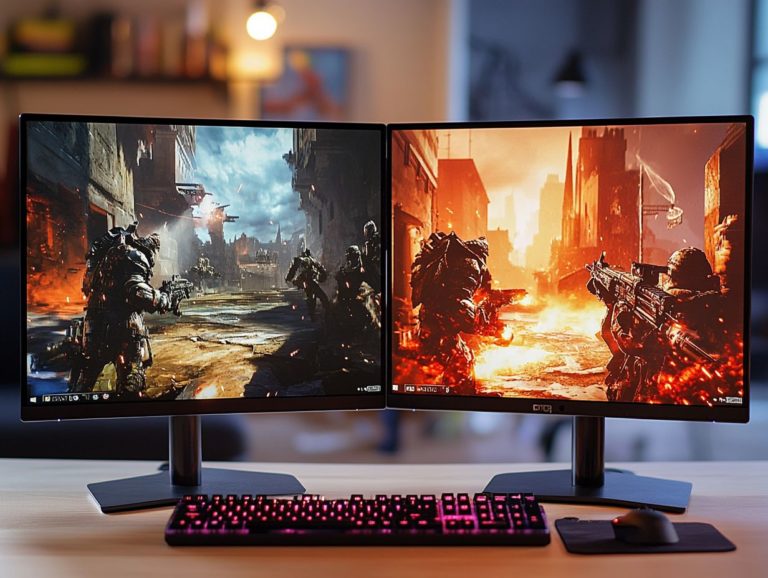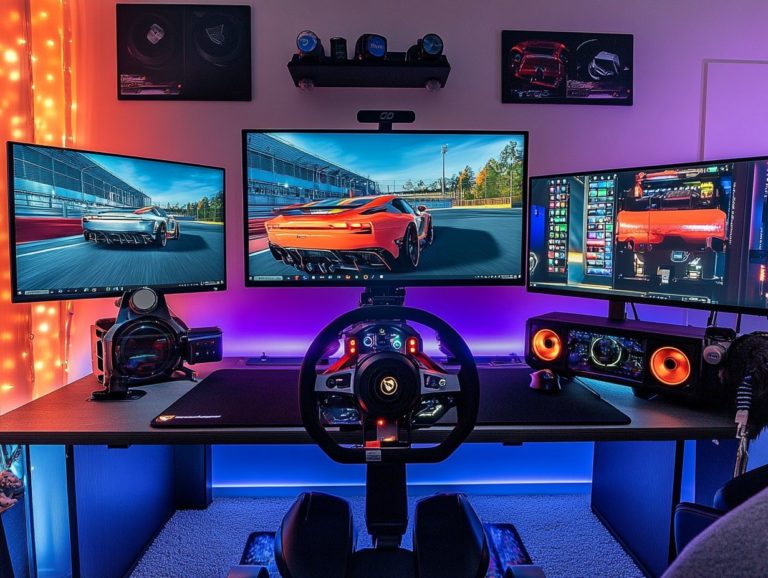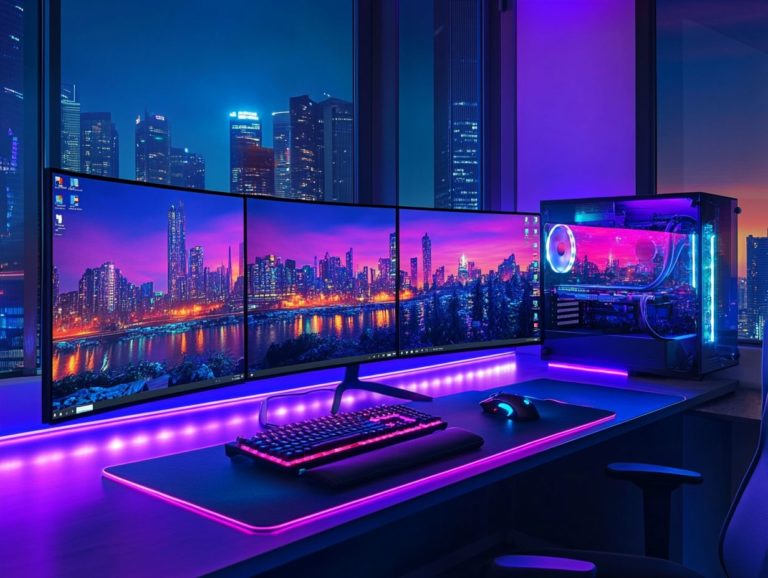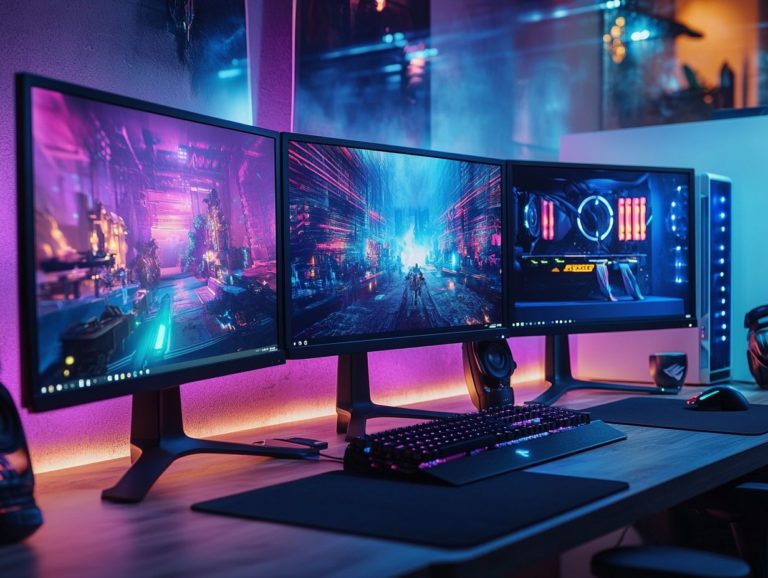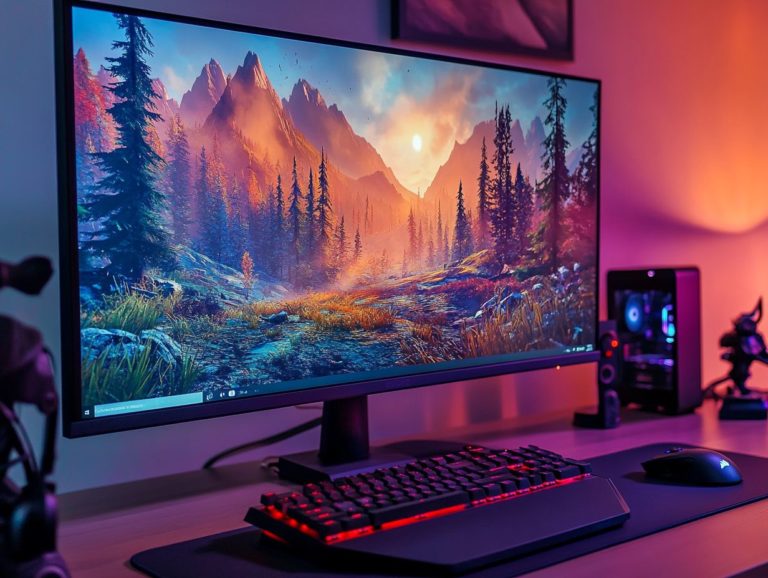5 best gaming monitors for graphic design
Choosing the right gaming monitor for graphic design can transform your creative workflow. With so many options available, it’s crucial to identify the features that make a difference such as resolution, color accuracy, and response time.
This guide covers essential aspects to consider, including ergonomic designs and connectivity options that enhance versatility. You ll find insights on the top five monitors tailored for graphic design needs, making it easier to find the perfect fit for your projects.
Selecting the right monitor can elevate your creative experience!
Contents
- Key Takeaways:
- What to Look for in a Gaming Monitor for Graphic Design?
- What Is the Ideal Resolution for Graphic Design?
- What Is the Importance of Color Range in Graphic Design?
- Why Is Fast Response Time Important for Graphic Design?
- How Can Ergonomic Design Improve Productivity for Graphic Designers?
- What Are the Different Connectivity Options Available for Gaming Monitors?
- Top 5 Gaming Monitors for Graphic Design
- 1. High Resolution and Color Accuracy
- 2. Wide Color Gamut
- 3. Fast Response Time
- 4. Ergonomic Design
- 5. Multiple Connectivity Options
- How Do These Monitors Compare in Resolution, Color Gamut, Response Time, and Connectivity?
- What Are the Pros and Cons of Each Monitor?
- Which Monitor Is the Best Overall for Graphic Design?
- Which Monitor Is the Best Budget Option for Graphic Designers?
- Which Monitor Is the Best for Color-Critical Work?
- Which Monitor Is the Best for Multitasking and Productivity?
- Which Monitor Is the Best for Gaming and Graphic Design?
- Which Monitor Offers the Best Value for Its Price?
- Frequently Asked Questions
- What are the 5 best gaming monitors for graphic design?
- What makes these monitors suitable for graphic design?
- What size should I consider when choosing a gaming monitor for graphic design?
- Do these monitors have adjustable stands?
- Are these gaming monitors also suitable for other tasks besides graphic design?
- What is the price range for these 5 gaming monitors for graphic design?
Key Takeaways:
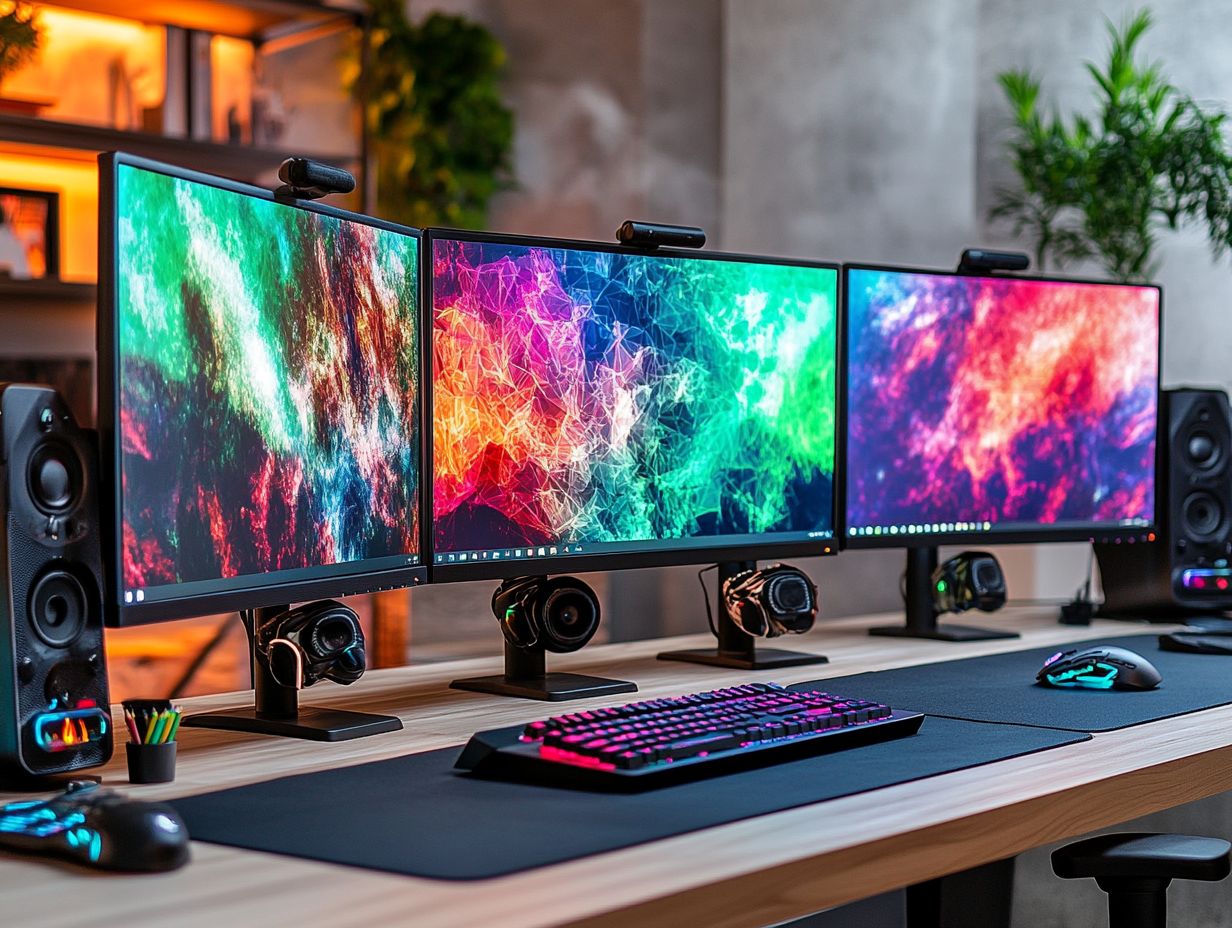
High resolution and color accuracy are key when choosing a gaming monitor for graphic design. Look for a wide color range and fast response time to create vibrant, precise designs. Ergonomic design and multiple connectivity options boost productivity for graphic designers.
What to Look for in a Gaming Monitor for Graphic Design?
When searching for the perfect monitor, blend specifications with features that ensure great performance. Focus on color accuracy and high resolution.
The ideal monitor will support various color ranges, like Adobe RGB and DCI-P3, essential for precise color representation. This guide explains display quality, panel type, and ergonomic design for a premium display experience.
Look for panel types like IPS. They offer wider viewing angles and superior color consistency, allowing for accurate assessments of your designs.
Enhanced resolution, such as 4K or higher, ensures intricate details are rendered clearly. This clarity is crucial for fine artwork and complex graphic projects.
Brands like BenQ and Asus are leaders in this field. They offer models that combine vital features while addressing designers’ needs, as users continually evaluate performance in real-world applications.
What Is the Ideal Resolution for Graphic Design?
The best image quality in graphic design often depends on resolution. 4K resolution is the gold standard for exceptional pixel density and display clarity.
This resolution sharpens the crispness of images and provides an expansive workspace, nurturing creativity and precision. With 4K’s impressive pixel density, you can appreciate every nuance and texture as intended.
Clearer visual elements make precise adjustments easy, leading to refined and polished results. By embracing this high-definition standard, you enhance your work’s quality, ensuring that the final product is stunning and relevant.
What Is the Importance of Color Range in Graphic Design?
In graphic design, color range is vital as it impacts accuracy and representation. Choose monitors that cover a wide spectrum, including Adobe RGB and DCI-P3.
A broader color range lets you explore a richer palette, enhancing creativity with vibrant hues. Accurately representing the full range of colors brings depth to your work.
Conversely, a limited range can dull your designs and frustrate your creative expression. Testing monitors ensures what you see on screen closely matches how it will appear in print or other formats.
This step is crucial for preserving the integrity of your original vision.
Why Is Fast Response Time Important for Graphic Design?
Fast response time is essential for graphic designers who enjoy gaming. It minimizes motion blur and improves image quality, which is crucial for effectively showcasing your design work.
When you opt for monitors that respond quickly, you can effortlessly navigate rapid scene changes without the distraction of ghosting artifacts.
For example, while a typical monitor may offer a response time of around 8ms, higher-end models can boast response times as low as 1ms. This makes them perfect for both dynamic content creation and high-speed gaming.
This sharpness and clarity become especially important in scenarios involving intricate graphics, where every detail matters. Displays with advanced refresh rates, such as 144Hz and above, complement fast response times, providing a seamless visual experience whether you re crafting a project or diving into a game.
The contrast between using an older panel and a modern display is striking. The latter showcases vibrant colors and smooth transitions, significantly enhancing both your productivity and enjoyment.
How Can Ergonomic Design Improve Productivity for Graphic Designers?
An ergonomic design is essential for you as a graphic designer. It significantly boosts your productivity by minimizing strain during those long work sessions.
Features like adjustable stands and optimal viewing angles cater perfectly to your multi-device workflows. This thoughtful integration allows you to customize your workstation to fit your unique needs.
By reducing discomfort, you can concentrate more fully on your projects, which naturally leads to higher-quality outcomes. With adjustable stands, you have the freedom to alternate between sitting and standing positions, combating fatigue and encouraging a more vibrant approach to creativity.
Tailoring your viewing angles ensures that every intricate detail is clearly visible, ultimately streamlining your workflow and amplifying overall efficiency in your creative process.
What Are the Different Connectivity Options Available for Gaming Monitors?
When selecting a gaming monitor for graphic design, it s essential for you to understand the various connectivity options, such as USB-C and Thunderbolt 3. This knowledge will help ensure seamless integration into your tech ecosystem while maximizing the monitor’s features.
These connections offer high transfer speeds that can significantly enhance your workflow, and they also support power delivery. This means you can power your devices and transfer data simultaneously an absolute game-changer. Such flexibility is vital if you often switch between different devices, like laptops and tablets.
A variety of ports, including HDMI and DisplayPort, guarantees compatibility with a wide range of hardware, enabling you to select the best setup tailored to your diverse needs.
By enabling easy connections, these options elevate your overall functionality and productivity in creative projects, allowing your imagination to soar without technical limitations.
Top 5 Gaming Monitors for Graphic Design
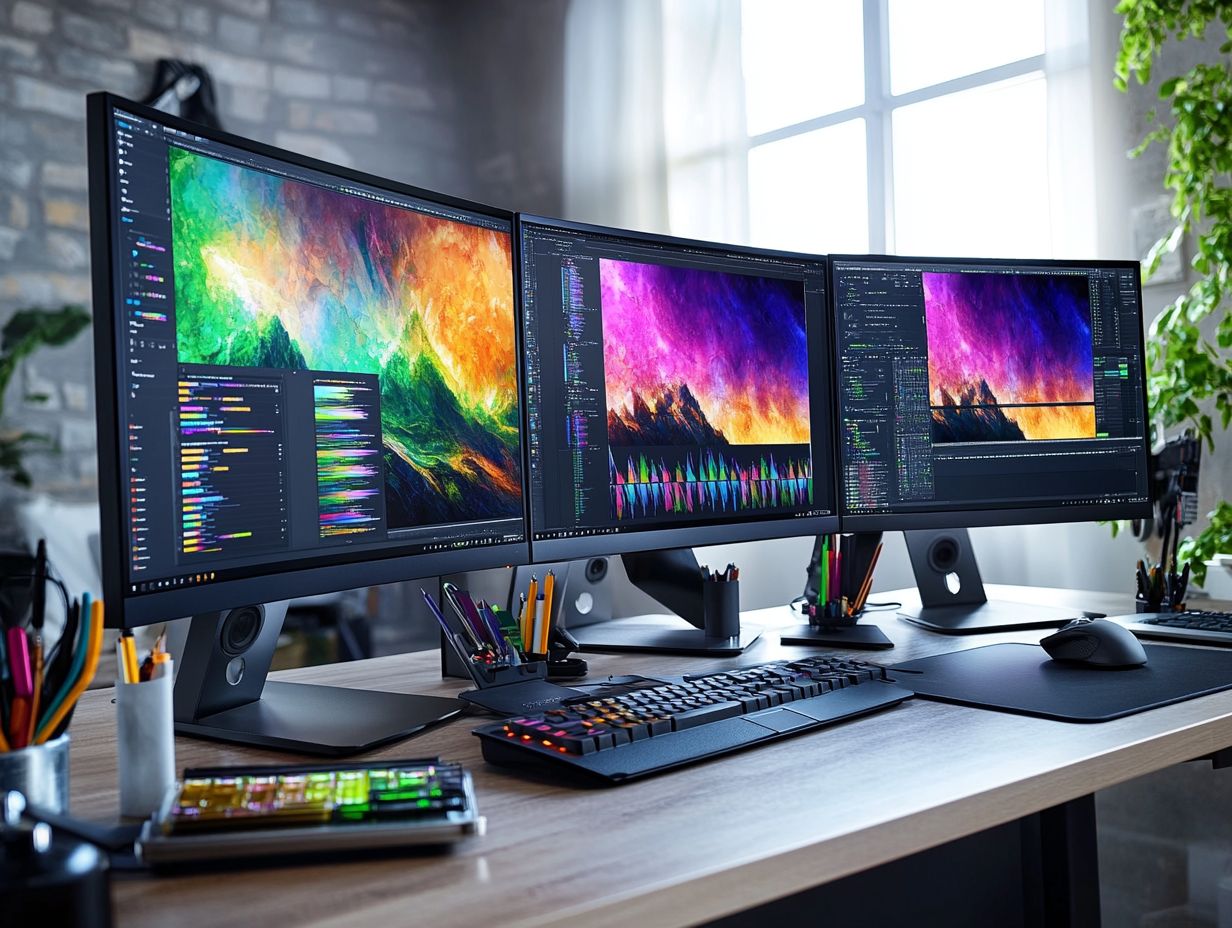
Choosing the right monitor is crucial! It can significantly shape your creative process. Here are the top 5 monitors for competitive gaming that every graphic designer should consider. They are known for their stunning color accuracy, 4K resolution, and exceptional display quality, featuring esteemed brands like BenQ, Asus, Philips, AOC, Dell, and Viewsonic.
These monitors offer stunning visuals and advanced features that every designer needs. Each model excels in reproducing vibrant, true-to-life colors, ensuring that every detail in your projects stands out brilliantly.
Their high dynamic range (HDR) a technology that makes colors look more vibrant and adds depth to images enhances contrast, making images leap off the screen and adding depth to your graphics.
Reviews emphasize the importance of ergonomic designs and adjustable stands, perfect for those extended work sessions. Built-in calibration helps maintain color fidelity over time, enabling you to produce top-notch content with complete confidence.
Explore these options now, and find the perfect monitor to enhance your graphic design work!
1. High Resolution and Color Accuracy
High resolution coupled with exceptional color accuracy is a defining trait of premium monitors, enabling you to achieve the finest image quality in your graphic design endeavors.
This level of detail enables you to carefully adjust your images, enhancing workflows that demand precision from digital illustrations to photo editing.
Maintaining impeccable color integrity is crucial when you’re working on projects involving branding or product design. It helps authentically represent the brand.
Monitors like the Dell UltraSharp series and the BenQ PD series have gained a reputation for their outstanding color reproduction and high pixel density, making them the go-to choices for professionals.
These models often incorporate technologies such as IPS panels, which stand for In-Plane Switching, improving color consistency and viewing angles. This allows your designs to shine across various devices and mediums.
2. Wide Color Gamut
A wide color gamut is critical for graphic designers, enabling accurate color representation where Adobe RGB and DCI-P3 coverage is essential.
This capability ensures that every hue, shade, and gradient is rendered with precision, greatly affecting the overall quality of your visual content.
In photography, video editing, and digital art, a monitor with great color fidelity is a necessity.
Monitors engineered with extensive color coverage can showcase a broader spectrum of tones, enriching the depth and vibrancy of your projects.
Regular monitor testing is essential to verify color accuracy and ensure that your display meets industry standards, giving you peace of mind that the visuals you create will be true to life.
3. Fast Response Time
Fast response time is essential for monitors tailored for graphic design, especially when diving into gaming or animation tasks. It enhances image quality and minimizes motion blur.
Swift response rates are vital for ensuring that fast-moving images stay crisp and clear, allowing you to appreciate the intricate details and vibrant colors that define high-quality graphics.
This is particularly relevant in professional settings, where monitors like the Dell UltraSharp U2720Q and ASUS ProArt PA32UCX shine. Both models boast impressive response times that elevate your visual experience.
By reducing ghosting and blurring, these monitors enable you to create dynamic visuals that captivate audiences, ensuring every frame bursts with life and clarity.
4. Ergonomic Design
The ergonomic design of a monitor can significantly elevate your productivity as a graphic designer by offering comfort and flexibility.
When you choose a monitor with adjustable stands and optimal screen positioning, you ll find it easier to maintain better posture. This drastically reduces the risk of neck and back strain.
This smart design keeps you comfy and lets you work longer without fatigue.
Consider models like the Dell UltraSharp series or the BenQ PD series, which showcase these ergonomic advantages by incorporating blue light filters and flicker-free technology to safeguard your eyes.
Choosing the right ergonomic monitor can transform your workspace into an inviting haven that fosters focus, enhances creativity, and maintains high productivity levels. It s a smart investment for any design professional.
5. Multiple Connectivity Options
Having multiple connectivity options, like USB-C and Thunderbolt 3, gives you the flexibility to connect various devices while maximizing your monitor’s features.
This versatility allows for smoother transitions between laptops, tablets, and high-resolution monitors, enhancing your overall creative process.
Effortlessly connecting to different peripherals without the hassle of adapters or complex setups streamlines your work, allowing you to focus on creativity rather than logistics.
Monitors equipped with robust connectivity options, including multiple HDMI, DisplayPort, and USB hubs, cater to your diverse professional needs.
These capabilities facilitate simultaneous connections, enabling the use of multiple displays that can significantly elevate your productivity and promote an efficient workspace.
Choose the right monitor today to elevate your design work!
In summary, selecting a premium monitor with high resolution, wide color gamut, fast response time, ergonomic design, and multiple connectivity options is essential for graphic designers looking to enhance their workflow and creativity.
How Do These Monitors Compare in Resolution, Color Gamut, Response Time, and Connectivity?
Comparing top gaming monitors reveals their strengths and weaknesses. This understanding helps you make informed choices, especially when considering options like the 5 high refresh rate monitors for gaming, as a graphic designer.
In design, precision and detail are crucial. A higher resolution offers sharper images, while a wider color gamut ensures better color accuracy.
A quick response time reduces lag, promoting smoother workflows, especially during video editing. Connectivity options are equally important; they affect how well your devices work together.
What Are the Pros and Cons of Each Monitor?
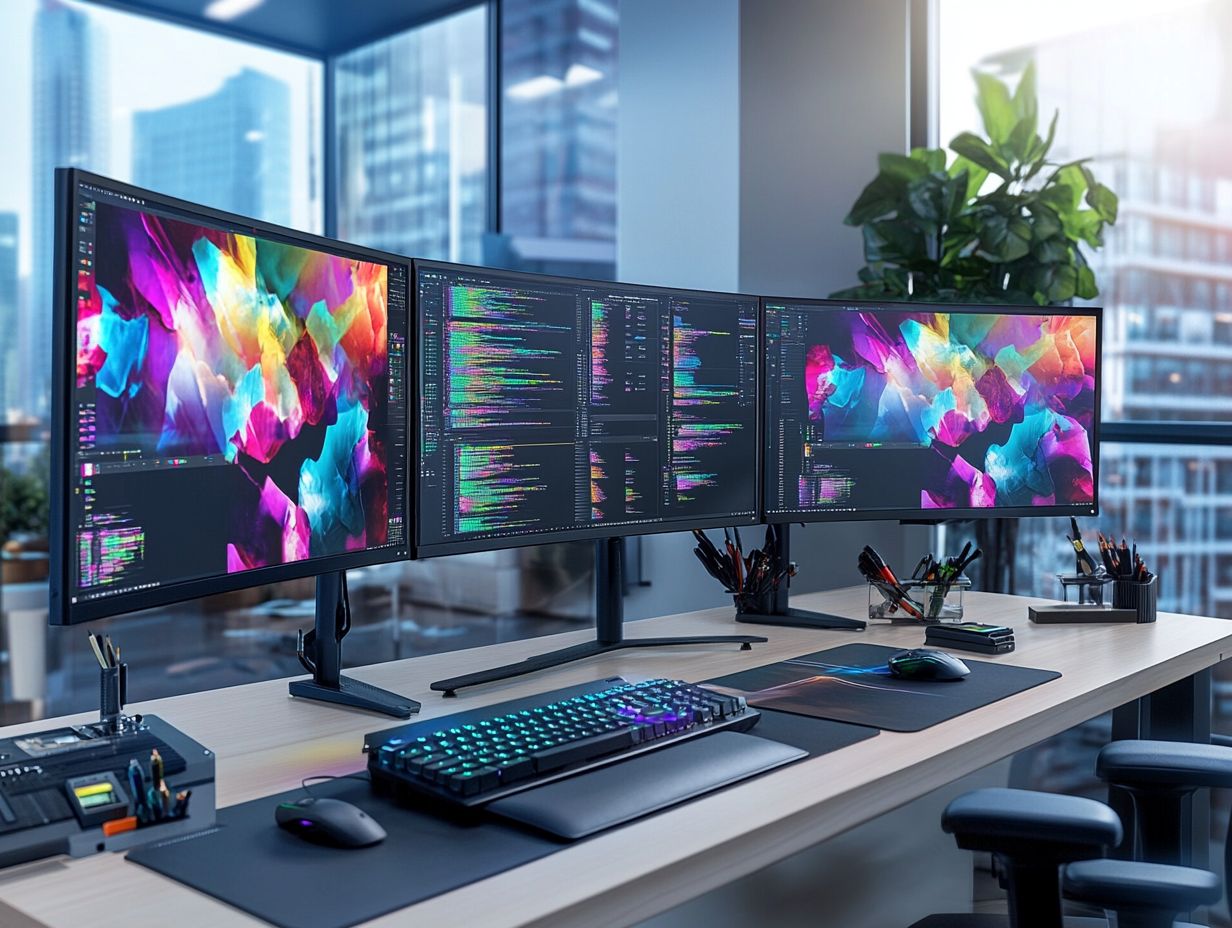
Every monitor has its unique advantages and disadvantages, especially for graphic design. Factors like resolution and image quality can dramatically impact your user experience.
Understanding your specific needs as a graphic designer is essential when weighing your options. Some monitors shine in vibrant color display and support various color spaces, which is crucial for precision in your work.
However, there s often a trade-off with the higher price tags associated with these features. Other monitors may deliver impressive performance at a more affordable cost, but compromises in picture quality could hinder your creative projects.
Quickly assessing these elements allows you to make informed decisions that truly align with your design workflow.
Which Monitor Is the Best Overall for Graphic Design?
Determining the best monitor for graphic design requires careful review of display quality and color accuracy. It’s not just about specifications; user experiences and 5 must-have features in gaming monitors provide insight into real-world performance.
As a creative, you want a display that boasts vibrant colors and sharp details. Look for adjustable stands and multiple connectivity options to streamline your workflow.
User reviews reveal that some monitors consistently receive high praise not just for impressive technical specs but for the satisfaction they provide during daily tasks.
By evaluating user satisfaction and performance comprehensively, you ll be well-equipped to find the best option for artists, photographers, and designers alike.
Which Monitor Is the Best Budget Option for Graphic Designers?
Finding the best budget monitor for graphic designers means striking a balance between performance and cost. Ensure essential features like display quality and color accuracy meet your needs while keeping within your budget.
In the competitive design realm, where clarity and precision are essential, you want monitors that won’t empty your wallet but still deliver a fulfilling visual experience. Many budget-friendly options are available, including gaming monitors with the best response times, which come with high resolution and a wide color gamut, suitable for intricate design work.
As you compare these monitors, scrutinize their ability to reproduce accurate colors, as this will directly influence your final output quality.
Some models offer adjustable stands and multiple connectivity options, enhancing usability without a significant price increase. Ultimately, your goal is to discover that sweet spot where functionality and affordability meet seamlessly.
Which Monitor Is the Best for Color-Critical Work?
For graphic design, choose a monitor with excellent color accuracy. Look for coverage of Adobe RGB and DCI-P3 to achieve precise visual results.
This attention to detail ensures your visuals appear exactly as intended, whether for print or digital mediums.
Monitors with IPS technology, a type of screen technology that offers better colors and viewing angles, are often preferred by professionals in photography and digital art.
Models like the Eizo ColorEdge CG319X and the Dell UltraSharp UP2720Q excel due to their factory calibration and extensive color support. You can work with confidence, knowing your creations will translate beautifully across various platforms.
Investing in these displays transforms your work, enhancing accuracy and elevating quality!
Which Monitor Is the Best for Multitasking and Productivity?
Ultrawide monitors boost multitasking in graphic design. They let you view multiple applications side by side, making comparisons and edits easier.
The expansive screen real estate reduces the time spent on minor adjustments, creating a smoother creative process.
Ergonomically designed models like the Dell UltraSharp U4919DW and the LG 34WK95U-W prioritize comfort with adjustable stands and eye-care technologies.
These features are essential for those long hours at your desk, helping you prevent strain and maintain productivity over extended periods.
Which Monitor Is the Best for Gaming and Graphic Design?
The best monitor for gaming and design balances high refresh rates with stunning image quality. For those streaming on platforms like Twitch, consider the 5 best monitors for streaming on Twitch which offer fast response times and vibrant colors.
Models like the Dell Alienware AW2521H and ASUS ProArt PA32UCX exemplify this ideal combination, boasting refresh rates exceeding 144Hz and impressive color ranges that satisfy discerning creatives.
With the right monitor, immerse yourself in captivating gaming experiences while confidently tackling intricate design projects, knowing your display caters to both passions.
Which Monitor Offers the Best Value for Its Price?
To find the best value monitor, assess features like color accuracy and resolution. Great models offer performance without breaking the bank!
This process demands a discerning eye for specifications and an understanding of how different models cater to your specific design needs.
Monitors with IPS technology often provide superior viewing angles and color reproduction, essential for creating visually stunning graphics.
User feedback highlights the importance of features like adjustable stands and connectivity options. Affordability doesn’t have to come at the expense of functionality.
Engaging in careful comparison and exploring real-world reviews can uncover top monitors for virtual reality gaming that provide a great balance between cost and advanced capabilities necessary for flawless graphic design execution.
Frequently Asked Questions
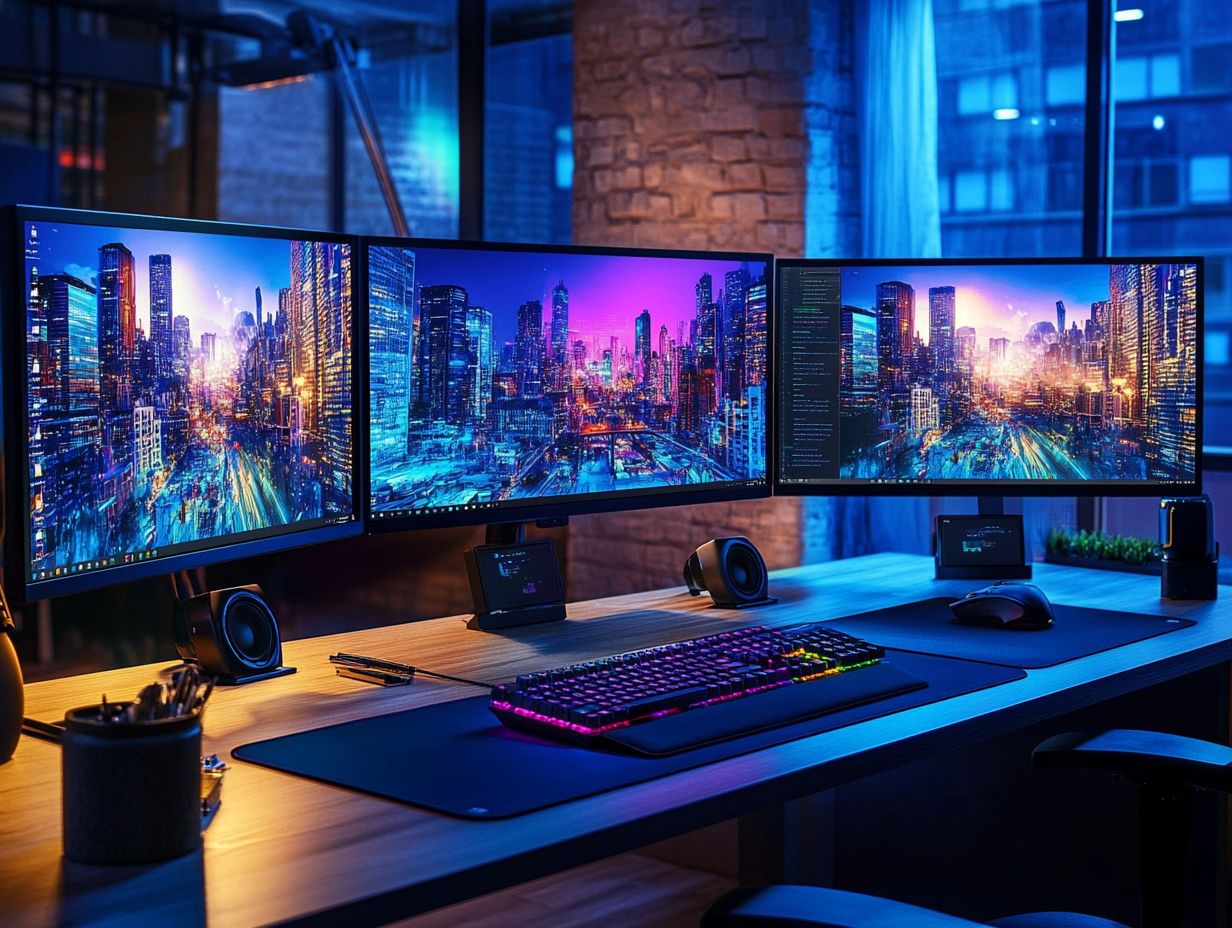
What are the 5 best gaming monitors for graphic design?
The 5 best gaming monitors for graphic design are the LG 27GL850, ASUS ROG Swift PG279QZ, Samsung CHG90, BenQ PD3200U, and Dell UltraSharp U2718Q.
What makes these monitors suitable for graphic design?
They offer high resolutions, accurate colors, and fast response times, perfect for graphic design work.
Discover the perfect monitor for your creative journey today!
What size should I consider when choosing a gaming monitor for graphic design?
For graphic design, choose a monitor that is at least 27 inches. This size offers ample space to work and enhances detail visibility.
Do these monitors have adjustable stands?
Yes, all five monitors come with adjustable stands. This feature lets you customize your viewing angle for better comfort.
Are these gaming monitors also suitable for other tasks besides graphic design?
Absolutely! These monitors are versatile. They’re great for gaming, video editing, and watching movies.
What is the price range for these 5 gaming monitors for graphic design?
The price varies significantly. The LG 27GL850 is priced around $500, while the Samsung CHG90 can reach up to $1,500.

